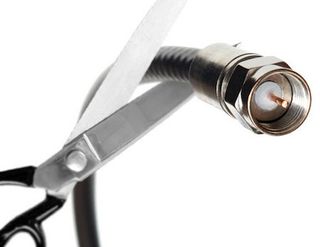Study: Hulu Subs More Likely to Cut Cord

Coming off the biggest first-quarter drop in pay TV subscribers ever, a just-released report by researcher M Science says that not only is cord-cutting accelerating, customers of over-the-top service Hulu are more likely to end their cable, satellite or telco TV relationship.
Pay TV subscribers declined by 762,000 in the first quarter, the single largest first-quarter drop in history and five times higher than losses in the prior year. The data has been widely used as evidence that cord-cutting not only is real, it’s getting worse.
M Science has developed a proprietary method to track cord-cutting by analyzing the frequency of various price declines across consistent paying subscribers, which it says provides a “directional indicator of cord-cutting behavior.”
According to M Science’s findings, Hulu customers are more likely to sever their pay TV relationship than subscribers to Netflix. The researcher found that Netflix customers on average spend about $1 less per month for cable service, a figure they found “non-concerning.” But Hulu subscribers pay $10 to $15 per month less for cable bundles than the average consumer, suggesting that “cord-replacement or displacement is relatively high among subscribers to Hulu’s legacy SVOD service, which is estimated to have between 12 million and 15 million subscribers currently.”
That aversion to pay TV isn’t just for cable. M Science found that Netflix customers are 30% less likely to subscribe to Dish Network and Hulu subscribers are 16% less likely to subscribe to the satellite service. That figure doubles to 32% if they subscribe to both Hulu and Netflix.
But M Science added Hulu customers seem to be bent on cutting the cord.
“The likelihood of Hulu subscribers also being pay-TV subscribers is declining,” the M Science study said. “This suggests increased replacement value relative to pay-TV over time, likely a function of both improved content and product, as well as broader industry pressure on pay-TV, in our view.”
Multichannel Newsletter
The smarter way to stay on top of the multichannel video marketplace. Sign up below.
While its still too early to tell, M Science said early indications show that Hulu coupled with another service like YouTube TV may be more “materially more disruptive” than current virtual MVPDs like Sling TV or DirecTV Now.
According to the study, Hulu “already exhibits a relatively high cord-displacement profile and it’s logical that its subscriber base could be more prone to pay TV replacement, rather than strictly cord-cutting. …Furthermore, both Hulu and YouTube already operate respective video services at scale, which we believe should make for higher-quality services at launch in comparison to the challenges faced by both Dish and DirecTV at the time of their respective vMVPD launches.”
And though the broadband/pay TV bundle remains powerful, the researcher added that may become less of a given. In the past, the combination of higher standalone broadband prices and the quality and functionality of cable video service were enough to keep the bundle intact.
“That may change as virtual MVPD services offer more channels and provide cloud DVR,” M Science wrote. “Most importantly, the content and experience is increasingly ubiquitous and seamless across devices, an area where we expect Hulu and YouTube to leverage their respective strengths.”
M Science also saw an acceleration in cord cutting at the two largest cable companies – Comcast and Charter – in Q2.
The second quarter is traditionally a bad one for cable operators as students cancel service after school ends and residential customers move to summer homes.
While the second quarter still has a few weeks to go – it ends on June 30 – M Science said its data shows that cord-cutting indications at Comcast have increased dramatically in the first two months of the period – consistent with a year ago. But the researcher added that the magnitude is greater year-over-year, meaning a higher percentage of Comcast’s subscribers are exhibiting signs of potential cord-cutting through the first two months of Q2 relative to the prior-year period.”
At Charter, cord-cutting has increased since its purchase of Time Warner Cable and Bright House Networks and the trend is continuing in Q2. According to M Science, cord-cutting indications were at record highs in May for Charter. Charter has said that the expiration of pricing promotions at the former Time Warner Cable systems has led to an increased level of cord-cutting at the company. In the first quarter, Charter said its former TWC systems made up the bulk of the loss of 100,000 video customers in Q1 while its legacy systems gained about 19,000 subscribers.
However, Charter chairman and CEO Tom Rutledge has said publicly that he believes those losses are beginning to subside.
